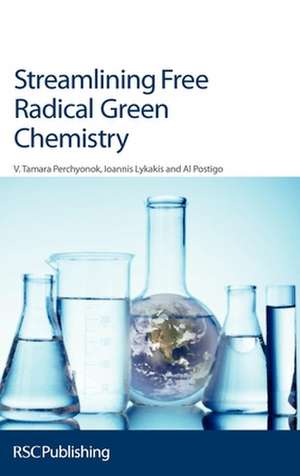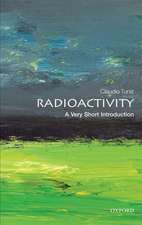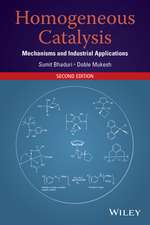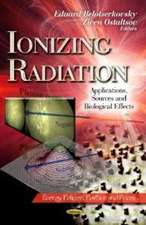Streamlining Free Radical Green Chemistry
Autor V. Tamara Perchyonok, Ioannis Lykakis, Al Postigoen Limba Engleză Hardback – 30 noi 2011
The environmental and health hazards created by industrial chemicals and consumer products must be minimized. For safer products to be designed, the relationships between structure and toxicity must be understood at the molecular level. Green chemistry combined with free radical research has the potential to offer innovative solutions to such problems. Some solutions are "greener then others", and many necessitate significant financial investment. New technology will only be adopted if real benefit can be shown and sometimes adaptation of existing methods is the best option. The efficiency of processes must be assessed, not only in terms of the final yield, but also cost, environmental impact and waste toxicity. This practical and concise guide showcases the sustainable methods offered by green free radical chemistry and summarizes the fundamental science involved. It discusses the pros and cons of free radical chemistry in aqueous systems for synthetic applications. All transformation steps are covered including initiation, propagation, and termination. Useful background knowledge is combined with examples, including industrial scale processes for pharmaceuticals and fine chemicals. The book helps chemists to choose appropriate methods for achieving maximum output using a modern, environmentally conscious approach. It shows that, armed with an elementary knowledge of kinetics, an understanding of the mechanistic and technical aspects, and some common sense, it is possible to harness free radicals for use in a broad range of applications. Streamlining Green Free Radical Chemistry is aimed at chemists, engineers, materials scientists, biochemists and biomedical experts, as well as undergraduate and postgraduate students. It encourages readers to question conventional methods and move towards the "Benign-by-Design" approach of the future. References to further reading are provided at the end of each chapter.
Preț: 585.24 lei
Preț vechi: 657.57 lei
-11% Nou
Puncte Express: 878
Preț estimativ în valută:
111.98€ • 116.69$ • 92.72£
111.98€ • 116.69$ • 92.72£
Carte tipărită la comandă
Livrare economică 03-17 aprilie
Preluare comenzi: 021 569.72.76
Specificații
ISBN-13: 9781849733328
ISBN-10: 1849733325
Pagini: 779
Ilustrații: 1
Dimensiuni: 164 x 240 x 53 mm
Greutate: 1.48 kg
Editura: Royal Society Of Chemistry
ISBN-10: 1849733325
Pagini: 779
Ilustrații: 1
Dimensiuni: 164 x 240 x 53 mm
Greutate: 1.48 kg
Editura: Royal Society Of Chemistry
Cuprins
Chapter 1 Development of Free Radical Green Chemistry and Technology: Journey through Times, Solvents, Causes, Effects and Assessments; Chapter 2 Classical Synthetic Free Radical Transformations in Alternative Media: Supercritical CO2, Ionic Liquids and Fluorous Media; Chapter 3 Solvent-Free Carbon–Carbon Bond Formations in Ball Mills and in the Solid State; Chapter 4 Microwaves in Synthesis: How do Microwaves Promote the Reaction in Conventional and Alternative Media?; Chapter 5 Asymmetric Free-Radical Reductions Mediated by Chiral Stannanes, Germanes, and Silanes; Chapter 6 Organic Radical Reductions in Water: Water as a Hydrogen Atom Source; Chapter 7 Tin-Free Radical Reactions Mediated by Organoboron Compounds; Chapter 8 Thiols as Efficient Hydrogen Atom Donors in Free Radical Transformations in Aqueous Media; Chapter 9 Advances in the Use of Phosphorus-centered Radicals in Organic Synthesis in Conventional Flasks: Advantages, Reasons and Applications; Chapter 10 Metal-based Homogeneous Catalysis and Free Radical Synthesis: Advantages, Developments and Scope; Chapter 11 Radicals and Transition-metal Catalysis: a Complementary; Solution to Increase Reactivity and Selectivity in Organic Chemistry; Chapter 12 Reagent Control in Transition-metal-initiated Radical Reactions; Chapter 13 Enantioselective Radical Reactions and Organocatalysis; Chapter 14 The Sunny Side of Chemistry: Green Synthesis by Solar Light; Chapter 15 Sonochemistry: Ultrasound Application in Radical Synthesis; Chapter 16 Black-light-initiated Free Radical Reactions for Synthetic; Applications, Micro-reactors and Modified Nucleoside Synthesis; Chapter 17 Photo-catalysis and Metal–Oxygen-anion Cluster Decatungstate in Organic Chemistry: a Manifold Concept for Green Chemistry; Chapter 18 Radical Domino Reactions: Intermolecular Telescopic Reactions; Chapter 19 Telescopic Reactions and Free Radical Synthesis: Focus on Radical and Radical–Ionic Multicomponent Processes; Chapter 20 Radical–Radical–Radical Telescopic Reactions: from Rules through Reasons to Applications; Chapter 21 Applications of Conventional Free Radicals and Advances in Total Synthesis: from the Bench to the Future through the Vinyl Radical; Chapter 22 Streamlining Organic Free Radical Synthesis through Modern Molecular Technology: from Polymer-supported Synthesis to Microreactors and Beyond; Chapter 23 Radical Reactions and b-Cyclodextrin as a MolecularFerrari: Is There a Hidden Advantage of Speed, Power and Class? From Fundamental Reactions to Potential Applications; Chapter 24 Artificial Enzymes and Free Radicals: the Chemist’s Perspective; Chapter 25 Applications of Conventional Free Radicals and Advances in Total Synthesis: from the Bench to Nature through SmI2 Radicals as an Efficient Trigger for Radical Cascades, a Journey from Orsay to the 21st Century; Chapter 26 Innovative Reactions Mediated by Zirconocene: Advantages and Scope; Chapter 27 Applications of Conventional Free Radicals and Advances in Total Synthesis: Radical Cascades in Bio-inspired Terpene Synthesis; Subject Index
Notă biografică
Dr V. Tamara Perchyonok is a Chief Scientist at VTPCHEM PTY Ltd and a Researcher at the School of Dentistry and Oral Health at Griffith University. Her research interests cover prototype drug delivery systems, functional nanomaterials, and analytical, nano and organic chemistry. The focus of her work is primarily on free radical chemistry, green analytical chemistry, molecular recognition and polymer chemistry. Prior to this she was a Marie Curie Senior Research Fellow at the ISOF, CNR in Bologna, a Senior Researcher at Chirogen PTY Ltd, and a DFG Post Doctoral Fellow at LMU in Munich. During this time, Dr Perchyonok's research interests covered both academic and commercial aspects of bio-compatible free radical chemistry via both experimental and computational approaches. Her current research interests include novel aspects of green analytical chemistry, synthesis and applications of new nano-materials, bio-compatible free radical chemistry, and novel aspects of dental materials and antioxidants in oral health. The overall aim is to develop prototype molecular drug delivery systems, functional dental materials, and alternative and recyclable technology to facilitate the conversion of bio-active compounds from waste into useful products. Ioannis N. Lykakis obtained his MSc and PhD in Organic Chemistry from the University of Crete. He subsequently became a Marie Curie Research Fellow at the ISOF, CNR in Bologna before undertaking post-doctoral research in the Department of Chemistry at the University of Crete. Dr Lykakis is currently a visiting Assistant Professor in the Chemistry Department of the University of Crete. His research focuses on catalysis, free radical chemistry and biomimetic models for mechanistic studies of biological processes. Al Postigo was born in Argentina and obtained his M.Sc. degree from University of Buenos Aires, Argentina in 1986. He then worked with Professor Dr. Erra Balsells in the area of Organic Photochemistry, in the Department of Organic Chemistry, Faculty of Science, University of Buenos Aires. He moved to Canada in 1990, and obtained his Ph.D. degree from McMaster University in 1994, under the direction of Professor Dr. William J. Leigh, studying the Photochemistry of Cyclobutenes and constrained s-cis dienes. After post-doctoral positions in Canada, he returned to Argentina and worked with Professor Dr. Roberto Rossi at University of Córdoba in the area of Radical Ion Reactions. He then earned a position of Assistant Professor at the Department of Organic Chemistry, Faculty of Chemical Sciences of that University. In 1999 he became a member of the National Argentinean Research Scientific Council, and remains a member since. In 2004, he accepted an Associate Professor position at University of Belgrano, Buenos Aires, in the Faculty of Science, and was promoted to Full Professor in 2008. In 2010 he earned a Professor Position at the Department of Organic Chemistry, Faculty and Pharmacy and Biochemistry, University of Buenos Aires. His current interests are in the areas of Radical Chemistry, both carbon-centered radicals and metallic centered-radicals. Particularly, he is devoted to studying radical reactions of these species in water and non-conventional media.
Textul de pe ultima copertă
The environmental and health hazards created by industrial chemicals and consumer products must be minimized. For safer products to be designed, the relationships between structure and toxicity must be understood at the molecular level. Green chemistry combined with free radical research has the potential to offer innovative solutions to such problems. Some solutions are "greener then others", and many necessitate significant financial investment. New technology will only be adopted if real benefit can be shown and sometimes adaptation of existing methods is the best option. The efficiency of processes must be assessed, not only in terms of the final yield, but also cost, environmental impact and waste toxicity. This practical and concise guide showcases the sustainable methods offered by green free radical chemistry and summarizes the fundamental science involved. It discusses the pros and cons of free radical chemistry in aqueous systems for synthetic applications. All transformation steps are covered including initiation, propagation, and termination. Useful background knowledge is combined with examples, including industrial scale processes for pharmaceuticals and fine chemicals. The book helps chemists to choose appropriate methods for achieving maximum output using a modern, environmentally conscious approach. It shows that, armed with an elementary knowledge of kinetics, an understanding of the mechanistic and technical aspects, and some common sense, it is possible to harness free radicals for use in a broad range of applications. Streamlining Green Free Radical Chemistry is aimed at chemists, engineers, materials scientists, biochemists and biomedical experts, as well as undergraduate and postgraduate students. It encourages readers to question conventional methods and move towards the "Benign-by-Design" approach of the future. References to further reading are provided at the end of each chapter.
Descriere
This practical, concise guide showcases the sustainable methods offered by green free radical chemistry and summarizes the fundamental science involved.










